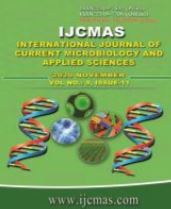


 National Academy of Agricultural Sciences (NAAS)
National Academy of Agricultural Sciences (NAAS)

|
PRINT ISSN : 2319-7692
Online ISSN : 2319-7706 Issues : 12 per year Publisher : Excellent Publishers Email : editorijcmas@gmail.com / submit@ijcmas.com Editor-in-chief: Dr.M.Prakash Index Copernicus ICV 2018: 95.39 NAAS RATING 2020: 5.38 |
Water is an important determinant factor of production of any crops in agriculture sector. Intensive and extensive cultivation of land depend mainly on the availability of water for irrigation. The various methods of irrigation are Flood, Furrow and Drip irrigation. The efficiency and risk of these irrigation methods is pivotal for agricultural development and any other new agricultural improvement of any region. So, this study concentrates on the economic efficiency and risk management strategies in flood, furrow and drip irrigation methods in Namakkal district of Tamil Nadu. Percentage analysis, Cobb-Douglas production function and Data Envelopment Analysis (DEA) were the analytical tools used to evaluate the objectives. The results revealed that economic performance for tapioca cultivation in drip irrigation was higher than the cotton cultivation in furrow irrigation and paddy cultivation in flood irrigation methods in terms of productivity and cost and returns. The net income for the tapioca cultivation was high over the cotton cultivation by 99.27 per cent and 117.37 per cent for the paddy cultivation. The results of resource use efficiency showed that manures and fertilizer cost, irrigation cost and plant production cost were significant in production of all the three crops. Economic efficiency in all the three irrigation methods showed that the irrigation resource was used at sub-optimal level and over utilization of seed and plant protection cost in flood and furrow methods respectively. Technical efficiency showed that all the paddy, cotton and tapioca crops in their respective irrigation methods was technically efficient since the mean level of technical efficiency is 95 per cent, 90 per cent and 91 per cent respectively. Scale efficiency indicated that all the paddy, cotton and tapioca crops in their respective irrigation methods operating at optimal size since the mean scale efficiency is more than 90 per cent for all the three crops. In case of risk management strategies, soil conservation and land management practices were ranked first in flood and furrow irrigation methods and effective irrigation management practices were ranked first in drip irrigation method.
 |
 |
 |
 |
 |